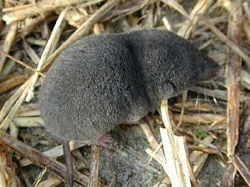Soricomorpha
| Soricomorpha
| ||||||||||||||
|---|---|---|---|---|---|---|---|---|---|---|---|---|---|---|
 Southern short-tailed shrew
| ||||||||||||||
| Scientific classification | ||||||||||||||
| ||||||||||||||
Soricomorpha is an order of placental mammals that includes the true shrews (family Soricidae); moles, shrew-moles, and desmans (family Talpidae); solenodons (family Solenodontidae), and members of the extinct family Nesophontidae. These families were originally placed in the now extinct order Insectivora. However, Soricomorpha is itself considered to be paraphyletic and often is replaced in taxonomic schemes with the order Eulipotyphla, with includes members of Soriciomorpha and the family Erinaceidae (hedgehogs and gymnures or moonrats).
Members of this order (as well as the order Eulipotyphla) are small mammals with long, narrow, and pointed snouts, ranging in size from but 3 grams and 3.5 centimeters to over 60 centimeters and over 1 kilogram. Soricomorphs are found in all continents except Australia and Antarctica.
Soricomorphs play key ecological roles in food chains, feeding on many invertebrates (larval insects, earthworms, snails, ) and small vertebrates (fish, frogs, lizards, mammals) as well as roots and plant parts and being preyed upon by many predators (mammals, birds, snakes).
Classification
Soricomorpha includes the three extant families of Soricidae, Talpidae, and Solenodontidae, and the extinct family Nesophontidae. Soricidae (true shrews) is the family of Soricomopha with the most known species, with about 300 species. Talpidae (moles, shrew-moles,and desmans) has about 42 known species, and Solenodontidae (solenodons) has two known extant species and two known extinct species. The final family Nesophontidae (West Indies shrews) placed in this order is only known in the fossil record.
In previous years, the soricomorphs formed a significant group within the former order Insectivora. However, that order was shown to be polyphyletic and various new orders were split off from it, including Afrosoricida (tenrecs and golden moles), Macroscelidea (elephant shrews), and Erinaceomorpha (hedgehogs and gymnures), leaving just the four families, leaving Insectivora empty and disbanded.
Subsequently, Soricomorpha itself was shown to be paraphyletic, because Soricidae shared a more recent common ancestor with Erinaceidae than with other soricomorphs (Roca et al. 2004). The combination of Soricomorpha and Erinaceidae, referred to as order Eulipotyphla, has been shown to be monophyletic (Beck et al. 2006).
- ORDER SORICOMORPHA
- Family Soricidae (shrews)
- Subfamily Crocidurinae: (white-toothed shrews)
- Subfamily Soricinae: (red-toothed shrews)
- Subfamily Myosoricinae: (African white-toothed shrews)
- Family Talpidae: (moles and close relatives)
- Subfamily Scalopinae (New World moles and close relatives)
- Subfamily Talpinae (Old World moles and close relatives)
- Subfamily Uropsilinae (Chinese shrew-like moles)
- Family Solenodontidae: solenodons (rare primitive soricomorphs)
- Family † Nesophontidae: West Indian shrews (extinct soricomorphs of the Caribbean)
- Family Soricidae (shrews)
Description
Soricomorpha means "shrew-form" and members of this order are small, have long, slim, and pointed rostrums, small eyes and short or absent ear pinnae. The smallest member of this order, the pygmy white-toothed shrew or Etruscan shrew (Suncus etruscus), is but 3 grams in weight and about 3.5 centimeters in body size. On the other hand, Cuban solenodons can reach 60 centimeters in size (Patsy et al. 2014). Shrews and solenodons have five-toed feet, while most moles have forelimbs modified for a fossorial life, such that they can "swim" through soil, while those moles those adapted to aquatic environments, such as desmans, have webbed feet. Moles fur is velvety and smooth. The small size of soricomorphs has resulted in their need to consume considerable amounts of food. In particular, the small size of shrews and their inability to store fat well has resulted in their need to consume large amounts of food, daily consuming 80 to 90 percent of their body weight and some much more than this, even up to four times that amount. The Eurasian pygmy shrew (Sorex minutus) must eat virtually all the time (Patsy et al. 2014).
Soricomorphs are found in all landmasses except those in the Australian and Antarctic regions. Members of Solenodontidae and Talpidae are fossorial, with desmans being semi-aquatic, found in areas such as swamps, rivers, streams, ponds, and marshes, and even fast-moving water. Soricomorphs tend to be solitary (Patsy et al. 2014).
ReferencesISBN links support NWE through referral fees
- Beck, R., O. Bininda-Emonds, M. Cardillo, F.-G. Liu, and A. Purvis. 2006. A higher level MRP supertree of placental mammals. BMC Evolutionary Biology 6: 93. PMID 17101039.
- Patsy, V., J. Song, R. Weber, and L. Siciliano Martina. 2014. http://animaldiversity.ummz.umich.edu/accounts/Soricomorpha Soricomorpha]. Animal Diversity Web. Retrieved May 31, 2014.
- Roca, A. L., G. K. Bar-Gal, E. Eizirik, K. M. Helgen, R. Maria, M. S. Springer, S. J. O'Brien, and W. J. Murphy. 2004. Mesozoic origin for West Indian insectivores. Nature 429(6992): 649–651. PMID 15190349.
| Mammals |
|---|
| Monotremata (platypus, echidnas) |
|
Marsupialia: | Paucituberculata (shrew opossums) | Didelphimorphia (opossums) | Microbiotheria | Notoryctemorphia (marsupial moles) | Dasyuromorphia (quolls and dunnarts) | Peramelemorphia (bilbies, bandicoots) | Diprotodontia (kangaroos and relatives) |
|
Placentalia: Cingulata (armadillos) | Pilosa (anteaters, sloths) | Afrosoricida (tenrecs, golden moles) | Macroscelidea (elephant shrews) | Tubulidentata (aardvark) | Hyracoidea (hyraxes) | Proboscidea (elephants) | Sirenia (dugongs, manatees) | Soricomorpha (shrews, moles) | Erinaceomorpha (hedgehogs and relatives) Chiroptera (bats) | Pholidota (pangolins)| Carnivora | Perissodactyla (odd-toed ungulates) | Artiodactyla (even-toed ungulates) | Cetacea (whales, dolphins) | Rodentia (rodents) | Lagomorpha (rabbits and relatives) | Scandentia (treeshrews) | Dermoptera (colugos) | Primates | |
Credits
New World Encyclopedia writers and editors rewrote and completed the Wikipedia article in accordance with New World Encyclopedia standards. This article abides by terms of the Creative Commons CC-by-sa 3.0 License (CC-by-sa), which may be used and disseminated with proper attribution. Credit is due under the terms of this license that can reference both the New World Encyclopedia contributors and the selfless volunteer contributors of the Wikimedia Foundation. To cite this article click here for a list of acceptable citing formats.The history of earlier contributions by wikipedians is accessible to researchers here:
The history of this article since it was imported to New World Encyclopedia:
Note: Some restrictions may apply to use of individual images which are separately licensed.